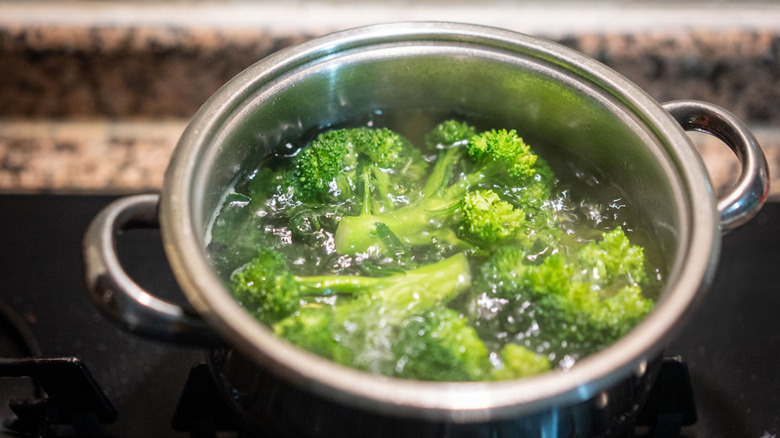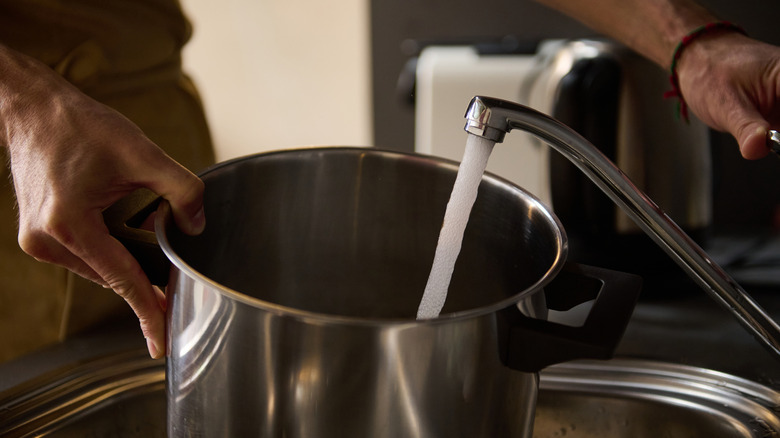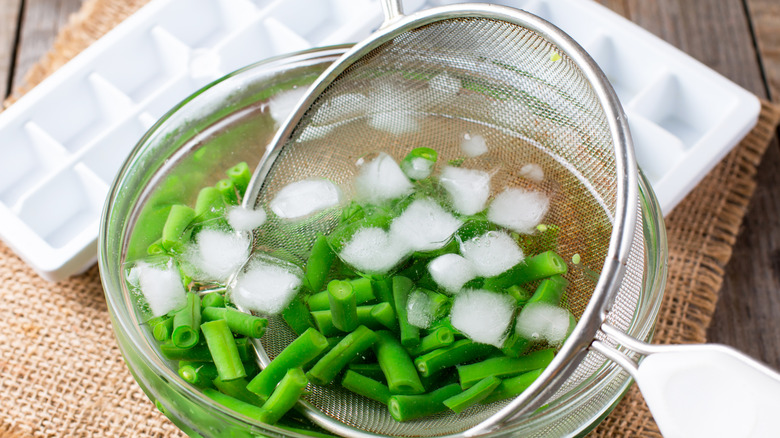The Absolute Best Liquid To Use When Blanching Veggies
Blanching is a helpful technique to have in your kitchen skills arsenal, especially if you're the type to freeze farmer's market fare. Blanching fruits and veggies involves a quick dunk in boiling water, followed by an immediate ice water bath. The boiling water bath — and the ice-cold shock that comes after — help kill bacteria and deactivate enzymes that make the vegetables deteriorate over time.
Blanching helps preserve color, flavor, and texture, so vegetables still taste fresh after a long stint in the freezer. It's also a great way to prevent vegetables from drying out while cooking in the oven or air fryer, and it helps if you need to peel thin-skinned fruits and veggies. I'll give fresh tomatoes a quick blanch if I don't have the pre-peeled canned variety on hand. The skin slips right off.
As with many super-simple techniques, it's easy to overthink the process. Will blanching veggies in other liquids, like wine or broth, improve the flavor? Should you use bottled water for a cleaner taste, or is tap okay? The Takeout asked chef Tara Punzone in an exclusive interview. Punzone knows her way around a vegetable patch: She's the author of Vegana Italiana and owner of Pura Vita, the first totally-vegan Italian restaurant and wine bar in the United States. She keeps it simple. "When I blanch vegetables I use tap water, or filtered tap water," she says. Don't bother blanching your vegetables with anything fancy. It's a waste of money — and could end up doing more harm than good.
Why you should blanch your vegetables in tap water
As long as you can trust your local tap water, it's the best bet for blanching veggies. Bottled water tends to be more acidic than the stuff that comes from your tap, and, according to Tara Punzone, that's something you want to avoid. "Most tap water is slightly alkaline which is more than perfect for this process," she exclusively tells The Takeout. "Acidic water can dull the color of the vegetables as the acidity breaks down the pigment, especially in green vegetables."
Blanching vegetables in other liquids could have unintended consequences. Wine is acidic, so skip the Chardonnay soak. While the pH of broth can vary, most broths are slightly more acidic than tap water. Besides, the vegetables won't have much time to soak up the flavor.
According to Punzone, salt is the only other thing you should add. "You should always be sure to use a large amount of heavily salted water," she says. The salt isn't just there for flavor, so don't skimp: The water should be briny. Salt helps prevent nutrients from escaping into the water and tenderizes the vegetables so they cook quickly. You'll rinse most of it off in the ice water bath, anyway, so don't worry about overdoing it.
Tips for blanching vegetables
Corn, broccoli, carrots, snap peas, and asparagus are all good candidates for blanching. You can blanch potatoes or greens like kale and spinach, too. Wash and prepare them, chopping them up in advance.
Use a big pot; the bigger the better. "Your vegetables should be floating around with lots of space for them to feel free to roll and tumble around for a few minutes," Tara Punzone exclusively tells The Takeout. The temperature of the water will drop when you add your vegetables, which means they could end up under-blanched. Under-blanching is worse than not blanching at all: The hot water briefly activates those pesky enzymes before deactivating them. If you take the vegetables out too soon, the enzymes will stay active even after you've shocked the vegetables with ice. Upping the water-to-vegetable ratio stabilizes the temperature.
You'll need to work quickly, so make sure you have plenty of ice-cold water and a strainer or skimmer on hand. "Let them enjoy their moment in the hot bath before you immediately plunge them into a freezing cold ice bath," says Punzone. Just remember that some vegetables are better at taking the heat than others: leafy greens only need a few seconds, while sturdier vegetables, like whole carrots, take around five minutes. Most take around two to three minutes. Strain them, then dunk them in ice. "The ice bath will shock them into preservation, and they will remain bright and full of life," Punzone says.


